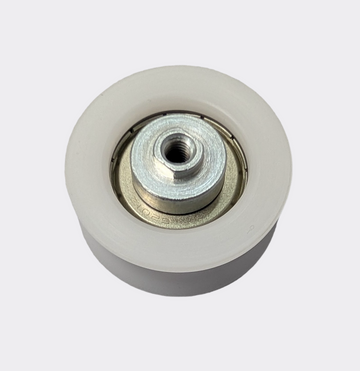
Record STA 20 Carriage Wheel – STM 20 Compatible Roller
Record STA 20 Carriage Wheel
The Record STA 20 Carriage Wheel is a dedicated replacement part designed for use with the Record STA 20 Automatic Sliding Door (also identified as the AGTA Record STM 20). It offers a practical and economical option for replacing single wheels, helping to maintain smooth and reliable door operation.
Key Specifications
-
Product Name: Record STA 20 Carriage Wheel – load/guide wheel used in System 20 carriage/trolley heads for standard linear sliding doors (Record, 2016).
-
Compatibility: For record System 20 / STA 20 operators; commonly used in STA 20 drive sets and related assemblies controlled by STM 20 / STM 20 DUO/RED (Record, 2016; Record, n.d.-b).
-
Typical Packaging: Sold per pair for one door leaf, and also supplied within carriage assembly kits (usually two carriages plus fixing pack).
-
Construction: Hard-wearing low-noise plastic running surface over ball-bearing hub for quiet, low-friction travel in the decoupled record running track (Record, 2016).
-
System Context (performance): STA 20 doors typically support up to 1 × 150 kg (single) or 2 × 120 kg (bi-parting) depending on model; reinforced STA 20-200 variants increase these limits (Record, 2016).
-
Use Case: Professional replacement for worn rollers/wheels in record sliding door parts inventories across retail, healthcare, transport, hospitality and corporate facilities (Record, n.d.-a).
FAQ
Q1. Is this the correct wheel for my Record STA 20 door?
A. If your operator is STA 20/System 20, this Record STA 20 Carriage Wheel is the standard running wheel used in the carriage/trolley heads. Many service kits use the same wheel geometry; verify by comparing the installed carrier style and the wheel profile/diameter.
Q2. I see “STM 20” on the controller. Does this “Record STM 20 wheel” fit?
A. Yes—STM 20 is the controller family used on System 20. The carriage wheels sit in the mechanical trolley; they are compatible with System 20 operators controlled by STM 20 or STM 20 DUO/RED (Record, n.d.-b; Record UK, n.d.).
Q3. How many wheels should I order?
A. A standard moving leaf uses two carriage wheels inside one carriage assembly; a bi-parting entrance uses four across two carriages. Many technicians replace wheels in pairs for even running and to minimize callbacks.
Q4. Are these wheels suitable for heavy traffic sites?
A. Yes. System 20 mechanics pair low-noise plastic rollers with acoustically decoupled tracks and ball-bearing pulleys to keep operation quiet and stable under high cycle counts—ideal for public buildings and retail (Record, 2016).
Q5. Do I need the whole carriage or can I buy wheels only?
A. Both approaches are common. If the carrier body and axles are still in good condition, wheels-only replacement is cost-effective. If axle/bushing wear is present, use a carriage assembly kit (two carriages + fixings).
Q6. What are the official part numbers I can cross-reference?
A. Service catalogs list the STA 20 trolley set as 08013247 (article) / 020808476 (manufacturer). Individual wheels are also offered as STA 20 Carriage Wheel by multiple suppliers.
Q7. Any setup notes after wheel replacement?
A. After changing wheels, re-level the leaf, set end-stops, confirm belt tension, and verify modes via BDE-D control (e.g., Automatic, Partial, Exit-Only). The STM controller’s self-learning routine stabilizes motion after commissioning (Record, n.d.-b; Record, 2016).
Product Description
The Record STA 20 Carriage Wheel is the primary load-bearing and guidance element inside every System 20 trolley head. If your entrance uses a record operator labeled STA 20 on the header or an STM 20 controller behind the cover, these wheels are the parts that keep the leaf suspended in the running track and gliding quietly day after day (Record, 2016; Record, n.d.-b). Because they sit at the heart of the moving gear, replacing worn wheels is the single most effective way to restore factory-smooth motion, reduce acoustic complaints, and keep forces within modern safety expectations.
Built for the System 20 ecosystem
System 20 was engineered by record as a modular platform for standard linear sliding doors. The mechanical package combines short low-inertia drive belts, acoustically decoupled track sections, ball-bearing idlers, and low-noise plastic rollers to minimize vibration transmission into the building fabric (Record, 2016). The STA 20 Carriage Wheel works in this ecosystem as the runner that supports the door leaf on two points inside each carriage. That geometry distributes load, stabilizes the sash against yaw, and delivers the “quiet, confident” travel associated with modern record sliding door installations (Record, 2016).
What the wheel actually does—and why it matters
Each moving leaf typically rides on two carriage wheels housed within one trolley head. As the STM controller accelerates and decelerates the door via the toothed belt, these wheels convert rotational motion into linear travel while maintaining precise alignment in the header profile (Record, 2016). When wheels develop flat spots, cracked treads, or dry bearings, the controller has to work harder to achieve target speeds and stops, which can lead to nuisance reversals and increased wear elsewhere. Fresh wheels with concentric treads and smooth bearings return the system to its intended friction profile so the door starts cleanly, tracks straight, and stops exactly where sensors and safety edges expect (Record, n.d.-b).
Material choice: quiet and durable
Record pairs a ball-bearing hub with a hard-wearing polymer running surface for each STA 20 wheel. The bearing ensures low rolling resistance and consistent geometry under load, while the polymer tread damps high-frequency vibration and reduces scuffing of the aluminum rail—two reasons System 20 doors are noticeably quieter than older metal-wheeled designs (Record, 2016). In high-traffic venues—retail galleries, transit concourses, hospital corridors—this material stack resists fatigue over long duty cycles and keeps entrances sounding premium even as cycle counts climb (Record, 2016).
Compatibility at a glance
If you see STA 20 on the product label or the controller indicates STM 20 / STM 20 DUO/RED, you are in the System 20 family and this Record STA 20 Carriage Wheel matches the intended running gear (Record, n.d.-b). Many service catalogs list a trolley set for the door wing under article numbers such as 08013247 and manufacturer number 020808476; those kits include two carriages and fixings, while wheels are also sold separately for cost-effective maintenance when the carrier body remains sound. This dual path—wheels-only or complete carriage assembly—keeps truck stock lean and first-time fix rates high.
Performance envelope and why wheel condition affects safety
Published System 20 envelopes show generous capacities: up to 1 × 150 kg for single-leaf doors and 2 × 120 kg for bi-parting sets, with reinforced STA 20-200 options for heavier sash weights (Record, 2016). While those limits are governed by the operator, profile, and glazing, the carriage wheels are the contact points that determine actual running friction and alignment. Keeping wheels in “as-new” condition helps the door operate comfortably within force targets and supports commissioning to current automatic-door safety frameworks when paired with appropriate sensors and edges (Record, 2016; Record, n.d.-a).
Where STA 20 wheels deliver the biggest ROI
-
Retail & malls: Quiet entries reduce perceived maintenance issues and protect brand ambience—especially during early or late trading when background noise is low (Record, 2016).
-
Healthcare & pharma: Smooth, predictable motion simplifies sensor zoning and reduces distractions near patient areas while supporting clean corridor flows (Record, n.d.-a).
-
Transport & hospitality: High cycle counts, stack effect, and temperature swings demand wheels that keep friction stable and geometry true (Record, 2016).
-
Corporate facilities: Low acoustic signature and consistent stopping points maintain the “premium lobby” experience and reduce callbacks (Record, n.d.-a).
Buying guidance
-
Identify your system. Look for “STA 20” on the header label or check the controller for “STM 20.” Photograph the inside of the header to document the carrier shape and wheel profile; this makes remote part matching fast and reliable (Record, n.d.-b).
-
Choose wheels-only or a complete carriage. If the carrier body and axle are intact, wheels-only replacement is efficient. If you see axle wear, bent brackets, or cracked carriers, order the carriage assembly kit (two carriages + fixings).
-
Plan quantities. A single leaf uses two wheels; a bi-parting set uses four across two carriages. Replacing in pairs per leaf keeps rolling resistance balanced and preserves alignment (Record, 2016).
-
Add common consumables. If the belt shows glazing or tooth wear, add a drive belt; verify end buffers and check the return pulley bearing for noise while the header is open (Record, 2016).
Installation/commissioning workflow
-
Mechanical swap: De-tension the belt, remove the carriage, and press out the worn wheels. Fit new Record STA 20 Carriage Wheels, confirming free rotation and correct spacers (Record, 2016).
-
Re-level and set stops: Re-hang the leaf, set the reveal and threshold clearances, and verify end-stop buffers (Record, 2016).
-
Run the learn cycle: With the BDE-D interface, trigger the STM controller’s self-learning routine so it measures travel, sets acceleration ramps, and stores stop positions (Record, n.d.-b).
-
Functional test: Prove Automatic, Partial-Open, and Exit-Only modes. Confirm sensor coverage and safety edge responses according to your local code and site policy (Record, n.d.-b; Record, 2016).
Key Features and Benefits
-
Direct Replacement WheelEnables individual carriage wheel replacement without installing an entire wheel assembly, providing a cost-efficient solution.
-
Reliable PerformanceDelivers consistent, smooth, and quiet door movement while minimizing operational interruptions and maintenance requirements.
-
Precision EngineeringDesigned to exact specifications to ensure full compatibility with Record STA 20 and AGTA Record STM 20 automatic sliding door systems.
-
Durable ConstructionManufactured from high-quality materials to endure frequent use and prolong the service life of automatic sliding doors.
-
Aftermarket ComponentReplacement part not originally supplied with the door system.
Why professionals standardize on this wheel
-
System-correct geometry aligned to System 20 carriers avoids the “almost fits” that cause rail chatter and premature wear (Record, 2016).
-
Low-noise tread and decoupled track design keep acoustic signatures low in prestige lobbies and clinical spaces (Record, 2016).
-
Portfolio efficiency: Common wheels across System 20 variants simplify stocking and reduce time-to-fix across multi-site estates described broadly as record sliding door parts programs (Record, n.d.-a).
-
Predictable commissioning: With wheels back to spec, the STM learn routine converges quickly and yields repeatable start/stop behavior that keeps the door within force targets (Record, n.d.-b).
Bottom line: If you maintain record entrances and need a fast, high-impact refresh, the Record STA 20 Carriage Wheel is the part that restores glide, reduces noise, and makes your STM 20 controller look brilliant again—often in a single service visit (Record, 2016; Record, n.d.-b).
References
-
Record. (2016). system20_nov2016_en_brochure (record system 20 brochure). https://www.recorddoors.com/master-blueprint/en/downloads/english/sliding-doors/standard-sliding-doors/record-sta-20-sliding-door/brochure/system20_nov2016_en_brochure.pdf
-
Record. (n.d.-a). Record STA 20 Sliding Door – product page (features, dimensions, standards). https://www.recorddoors.com/group/en/products/automatic-sliding-doors/standard-sliding-doors/record-sta-20-sliding-door
-
Record. (n.d.-b). System 20 Manual / User documentation (BDE-D, commissioning, STM 20 settings). https://www.recordukdirect.co.uk/media/Sliding%20Doors/STA20/STA20Manual.pdf






